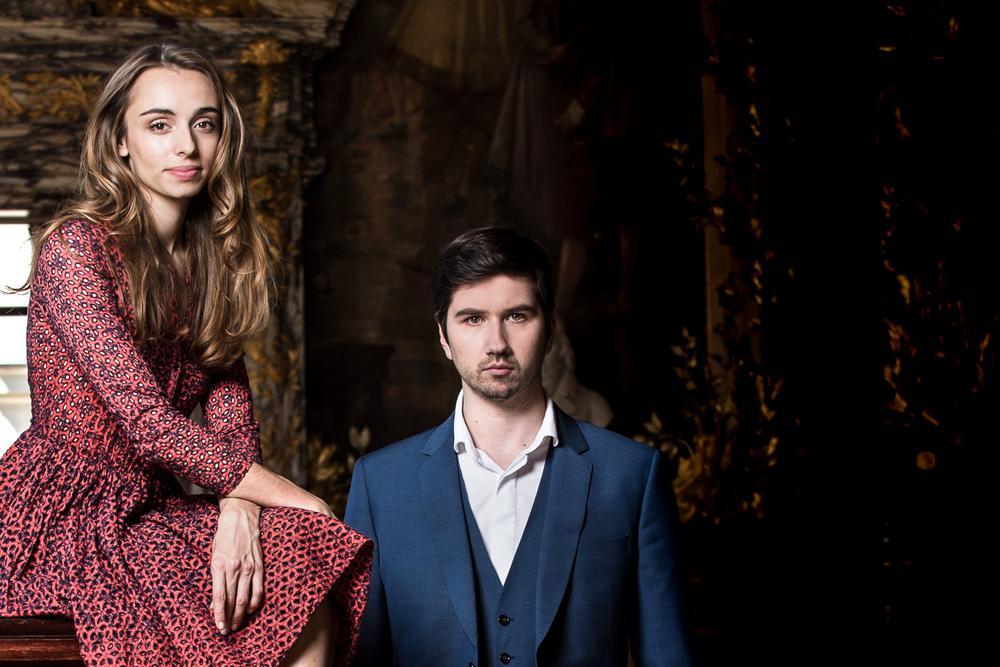Desandre and Dunford speak softly when they speak of love at Weill

Even the cozy confines of Carnegie Hall’s 268-seat Weill Recital Hall felt a bit too big for Thursday’s intimate recital of 17th-century Italian love songs by mezzo-soprano Lea Desandre and lutenist Thomas Dunford. Unfortunately, the bedchamber of the Duke of Florence wasn’t available.
A prominent notice in the program read, “To avoid disrupting the performers and fellow concertgoers, please make every effort to turn the pages as quietly as possible.” That was wise advice, as 200-odd pages flapping at once would surely have drowned out the subtle shadings of Dunford’s lute.
Desandre’s opera-capable voice would have fared better—she had earned praise, after all, for singing Mozart’s Despina at Salzburg—but even she kept it on the down-low until the evening’s very end.
The concert’s lighting cooperated, a mere glow onstage with just a soft spot on the performers (so tightly focused that when Dunford stood up for a bow, his upper half disappeared). The audience sat in near-darkness, which prevented reading along in the song texts. That made the sequence of short songs hard to follow, but at least it took care of the problem of noisy page-turning.
Thus, the burden of conveying meaning was, even more than usual, on the performance itself, with its delicate nuances of timbre and mood. Singer Desandre molded her flexible instrument to the poetic texts, inward-looking here, pushing a low note for emphasis there, slipping in and out of vibrato, butterfly-like in her inflections.
Dunford responded with artful phrasing of his own, bringing color and shape even to the ostinatos often featured in the songs’ lute parts. He also displayed virtuosity (of the lean-forward-to-hear-it variety) in four solo toccatas by Giovanni Girolamo Kapsberger, sprinkled among the songs on the program. His command of the instrument was evident not just in digital agility but in expressive cantabile and a wide tonal palette.
The program—with its overall title, “Lettera Amorosa” (Love Letter), borrowed from a song by Monteverdi—was a sort of Italian analogue to the pair’s recent album “Idylle,” a similar collection of French love songs. Both artists have been prominent soloists on the early-music scene since their early twenties, and have toured and recorded with the ensemble Jupiter, which Dunford founded in 2018.
These ventures into art song by composers now mostly known for other genres—Monteverdi for madrigals and operas, Frescobaldi for brilliant keyboard works, even the lutenist Kapsberger—showed how popular songs and dances enlivened the more cultivated music of the time. (Funny how that seems to happen in every era.)
Desandre intoned the long texts of Monteverdi’s “Si dolce è’l tormento” (How sweet is the torment) and “Lettera amorosa: Se i languidi miei sguardi” (Love letter: If my languid glances) in a speech-like rhythm, expressively speeding up and slowing down, and did likewise, but more softly, in Kapsberger’s lullaby “Figlio dormi” (Sleep my son).
In contrast, Frescobaldi’s “Se l’aura spira” (If the aura blows away) swung to the lute’s animated picking and strumming like a village dance. The dance idea continued, a little more sedately, in another lute solo, Juan Ambrosio Dalza’s “Catala alla Spagnola” (Catalan dance from Spain).
If the reputation of Tarquinio Merula isn’t as glowing as those of his above-mentioned contemporaries, it probably deserves to be, on the evidence of his two contributions to Thursday’s program. “Canzonetta spirituale sopra alla nanna” (Spiritual canzonetta on a lullaby) touchingly found the Virgin Mary softly singing the baby Jesus to sleep while envisioning his cruel fate. “Folle è ben che si crede” (It is foolish to believe) expressed a lover’s determination in obsessive harmonies over rapid lute tremolos.
A visitor from the next century, G.F. Handel, crashed the party as Desandre and Dunford leavened their largely unfamiliar program with sweetly intimate renderings of two of his most famous arias d’affeto, “Lascia la spina” (Leave the thorn)–better known with a different text as “Lascia ch’io pianga” (Let me weep)–and “Ombra mai fu” (Never was a shadow).
After so much hushed music-making, the closing number, Monteverdi’s “Quel sguardo sdegnosetto” (That disdainful look), startled with its rapid diction, yelping vocal gymnastics and forceful high notes at the end, touching off a mini-tempest of applause in the small hall.
The performers responded with two items from what Dunford called “our French album,” ending with a laid-back but still swinging rendition of “Le temps de l’amour” (The time for love), which was a hit for chanteuse Françoise Hardy in the 1960s.
Carnegie Hall presents Les Violons du Roi, Jonathan Cohen, music director, with guitarist Miloš, in works by Vivaldi, Marcello, Boccherini, Bach, Handel, Telemann, Rameau, Weiss, and Purcell, 7:30 p.m. Nov. 30 in Carnegie’s Zankel Hall. carnegiehall.org